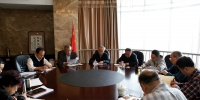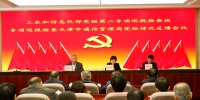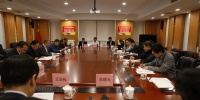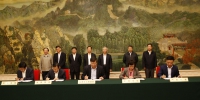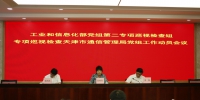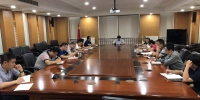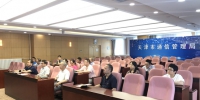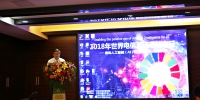苗圩:深化制造业开放合作 促进全球经济包容性增长
2018年4月20日,中国日报刊发工业和信息化部部长苗圩英文署名文章《Further opening up of manufacturing to promote global growth》,中国日报网发布该文章中文版《深化制造业开放合作 促进全球经济包容性增长》。现将原文转载如下:
深化制造业开放合作 促进全球经济包容性增长
西方有句谚语“一棵树挡不住寒风”,中国有句格言“众人拾柴火焰高”。开放合作、互利共赢,在此基础上构建人类命运共同体,正日益成为全球共识。
2018年是中国共产党十九大后的开局之年,也是中国改革开放40周年。纵观改革开放40年的历程,中国制造业秉承开放发展的理念,坚持引进来和走出去并重,坚持多边开放与区域开放结合,逐步从政策性开放向制度性开放转变,成为中国对外开放的重要窗口和合作共赢的重要领域。
40年来,中国发生了巨大变化,成为世界制造业生产和出口大国、制造业领域利用外资大国和境外投资大国,逐步融入国际产业分工体系,对全球经济增长作出了重要贡献。2017年,中国货物进出口总额达到4.1万亿美元,是1978年的783倍;制造业领域实际利用外资达335亿美元,对外直接投资累计1201亿美元,中外互惠合作的范围、层次和方式不断拓展,中国制造业全面开放的格局已经形成并不断深化。
开放领域不断扩大。 制造业一直是外商投资的重点领域,2017年中国制造业新设立外商投资企业4986家,同比增长24.3%。新修订的《外商投资产业指导目录(2017年)》,大幅压减了对外商投资的准入限制,在制造业31个大类、179个中类和609个小类中,完全对外资开放的已有22个大类、167个种类和585个小类,分别占71%、93.3%和96.1%。与此同时,中国企业海外投资近年来也呈现强劲增长态势,制造业占海外投资比重三分之一以上,覆盖纺织、食品、机械、汽车、电子等众多领域,为合作双方带来丰厚回报。例如,2010年吉利公司收购沃尔沃后,经过一系列战略调整,到2015年沃尔沃全球共销售50多万辆汽车,创下该品牌建立88年来的历史新纪录,助力沃尔沃走出困境并重新焕发生机。在这一过程中,吉利也提升了自身管理水平,并通过协同和规模效应与沃尔沃形成互利共赢的共同体。
合作区域不断拓展。 从经济特区到沿海开放城市再到中西部地区,中国制造业形成了全方位、多层次、宽领域的对外开放格局。1980年,中国在深圳设立第一个经济特区,各国的资金、技术和人才陆续来到深圳,并通过这个窗口打开960万平方公里的巨大市场。时至今日,大众、西门子、苹果、英特尔、三星、丰田、塔塔等世界500强企业的身影已经遍布中国东中西部地区,绝大多数企业都获得了良好的投资回报。近几年,在继续坚持引进来的同时,中国政府鼓励中资企业积极走出去。通过“一带一路”建设,中国制造企业境外投资从过去主要投向欧洲、北美和东南亚地区不断拓展到其他区域,很多企业积极到沿线国家投资兴业,开展国际产能和装备制造合作。中国同哈萨克斯坦、马来西亚等30多个国家签署了产能合作有关文件,对接规划和项目,一批沿线国家急需的钢铁、有色金属、建材等领域重大项目在市场化运作中稳步实施,一批境外产业园区相继落成,为相关国家推动工业化、现代化进程作出了实实在在的贡献。
开放层次不断提高。 近年来,外商投资的重点从加工制造逐步拓展到计算机、集成电路、智能制造等高新技术领域,在中国设立区域总部、研发中心的跨国公司近2000家。如中法企业达成共建“中法工业联合创新中心”合作意向,法国达索系统公司将在动态仿真、增材制造、多机器人先进制造等领域与中方开展深度合作,打造未来制造业创新技术孵化平台。2017年,高技术制造业实际使用外资665.9亿元,同比增长11.3%;其中,电子及通信设备制造业、计算机及办公设备制造业、医疗仪器设备及仪器仪表制造业同比分别增长7.9%、71.1%和28%。中国企业境外投资的规模和层次也在快速提升。2012年,中国对美直接投资首次超过美国对华投资;2016年,中国对美直接投资达169.81亿美元,同比增长111.5%。在进入“全球产业20强”的中国工程机械制造商中,徐工、中联重科、三一、柳工等企业几乎都在欧洲建立了研发机构。
合作渠道日趋常态化。 在推动“中国制造2025”实施过程中,中国主动对接其他国家的制造业发展战略,利用各种多边、双边合作机制推动制造业国际合作,与德、法等国在战略对接、标准制定、园区建设等方面积极开展对话与合作,涌现出许多中外合作典范。目前,已建立了中国-东盟投资合作基金、中拉产能合作投资基金、中欧共同投资基金、中墨投资基金、中法第三方市场合作共同基金等,旨在促进双边制造业合作发展。同时,中美、中德在智能制造、工业互联网等领域的合作不断深化。如,美国通用电气公司也在工业互联网技术、标准、联盟等领域与中国企业开展务实合作。又如,中德在智能制造领域围绕产业、标准化、人才培养、示范园区等重点合作方向,开展了智能制造及生产过程网络化合作试点示范,促进中德双方互学互鉴,在合作新模式中实现互利互惠。
平等互惠性不断增强。 开放的中国制造业受益于国外资本、技术和人才的投入,也持续为外资企业提供了良好回报。2017年,中国乘用车共销售2472万辆,其中德系、日系、美系、韩系和法系乘用车销量分别达到485万辆、420万辆、304万辆、114万辆和46万辆,分别占乘用车销售总量的19.6%、17.0%、12.3%、4.6%和1.8%。中国制造企业海外投资也给当地带去资金、技术和产品,解决了当地的就业、发展和税收,不断上演双赢和多赢的故事。截至2017年底,仅中国企业在境外经贸合作区累计投资就达到307亿美元,上缴东道国税费24.2亿美元,为当地创造就业岗位25.8万个。美中关系全国委员会报告显示,中国企业在美国俄亥俄州直接雇佣了超过14万名美国人,不仅为当地贡献了宝贵的税收和就业机会,也有助于维护和提升当地公共设施建设。对此,《华尔街日报》认为中国投资重振美国“铁锈地带”。
40年来,改革开放有力地推动了中国制造业的快速发展,不仅支撑了中国经济的持续较快增长,也为全球经济稳定增长作出了突出贡献。按照联合国发布的《2018年世界经济形势与展望》报告,2017年全球经济将增长3%,中国对全球经济增长的贡献率约为三分之一。在华外资企业普遍受益于中国经济增长,美中贸易全国委员会最近发布的《2017年中国商业环境调查》称,95%的受访公司在中国持续保持盈利,且三分之一的公司表示其在华业务比在其他市场的业务盈利高。
伴随着中国制造业的崛起,一些人担心,中国制造业发展中存在的产能过剩等结构性问题外溢,将会对其他国家产业发展带来较大冲击;也有一些人担心,中国政府推出“中国制造2025”,仅仅有利于本土企业发展,将会对其他国家企业设置不公平竞争障碍。这些疑虑是没必要的,正如习近平总书记在中国共产党十九大报告中指出的那样,“中国开放的大门不会关闭,只会越开越大”。无论过去、现在,还是未来,互利共赢、开放合作都是中国制造业发展过程中坚持的根本原则。同时,中国制造业对外开放还需要进一步扩大开放领域,提高政策透明度和稳定性,优化政府服务效能,持续改善营商环境。
我们将在制造业已基本开放的基础上,进一步落实汽车、船舶、飞机等行业开放要求,放宽外资股比限制特别是汽车行业外资股比限制,并加强同国际经贸规则对接,为外商提供更多更好的投资机会。
我们将扎实推进“一带一路”建设。发挥好企业、协会、园区、政府等多方作用,提高服务水平,引导更多的中国企业到沿线国家投资兴业,建立高水平的研发中心、制造基地和工业园区等。面向“一带一路”建设带来的巨大需求,推进与沿线国家在智能制造、工业互联网、5G、车联网、中小企业、民用航空、网络安全等领域的交流合作,实现多方互利共盈。
我们将持续优化营商环境。坚持“中国制造2025”及其相关政策措施一视同仁地适用于所有在中国境内的企业,包括内资企业和外资企业。建立健全外商投资准入前国民待遇加负面清单管理机制,切实降低制度性交易成本,强化知识产权保护,提升事中事后监管能力和水平,为全球投资者营造一个稳定公平透明、法治化、可预期的营商环境。
开放带来进步,封闭必然落后,这已被古今中外的发展实践反复证明。面对复杂多变的国际形势,没有哪个国家能够独立应对各种挑战,也没有哪个国家能够退回到自我封闭的孤岛。我们将继续秉承开放合作的理念,坚持市场化导向,更深更广融入全球供给体系,在开放合作中积极履行社会责任,与世界各国一道,携手努力、共同担当、同舟共济、共渡难关,推动经济全球化朝着更加开放、包容、普惠、平衡、共赢的方向发展,努力构建人类命运共同体。
Further opening up of manufacturing to promote global growth
"A single tree cannot block the chilly wind," goes a European saying. Similarly, a Chinese proverb says: "Many hands make light work." It is becoming a global consensus to build a community of shared future for humankind based on openness and win-win cooperation.
This year 2018 is the first year after the 19th National Congress of the Communist Party of China, and also marks the 40th anniversary of China's reform and opening-up.
Throughout the past 40 years, China's manufacturing industry has remained committed to the philosophy of open development, the development path of "bringing in" and "going global", and opening up both at multilateral and regional levels. Therefore, the manufacturing sector has gradually shifted from policy-oriented to institutional opening-up, becoming an important part of the overall national opening-up process for win-win cooperation.
The past four decades also have witnessed profound changes in China. As far as manufacturing is concerned, China has become the leading country in the world in terms of production, export, foreign investment utilization and overseas investment. And China's manufacturing sector is gradually integrating into the global industry division of labor, contributing significantly to global economic growth.
In 2017, China's total import and export of goods reached $4.1 trillion, which is 783 times of that in 1978. For the manufacturing sector, the annual actual utilization of foreign capital reached $33.5 billion and direct overseas investment amounted to$120.1 billion, with mutually beneficial cooperation with foreign countries expanding in scope, level and approach. A framework of all-round opening-up of the manufacturing sector is also taking shape and continues to develop.
Scope of opening-up continues to increase
The manufacturing sector has remained a key area for foreign investment. In 2017, there were 4,986 newly established foreign-invested manufacturing enterprises in China, up 24.3 percent year-on-year. The recently revised Catalogue for the Guidance of Foreign Investment Industries (2017) has substantially reduced the access restrictions for foreign investment. In terms of manufacturing products, 22 of the 31 categories, 167 of the 179 subcategories, and 585 of the 609 branch-categories are fully open to foreign investment, accounting for 71 percent, 93.3 percent and 96.1 percent, respectively, of the categories.
In recent years, the momentum of Chinese enterprises' investment abroad has been growing vigorously. The manufacturing sector takes up more than one-third of the total overseas investment, covering areas such as textiles, food, machinery, automobile and electronics, and generating enormous economic returns for both sides.
For example, Geely acquired Volvo in 2010. After a series of strategic adjustments, Volvo sold more than 500,000 vehicles worldwide in 2015, a record high in its 88-year history, helping the company overcome its difficulties and regain business vitality. During the process, Geely also improved its management and established with Volvo a community of shared interests through collaboration and scale effect.
Areas of cooperation continue to expand
From special economic zones at the beginning to opening up coastal cities and central and western regions later, the opening-up process for China's manufacturing sector is becoming multi-dimensional, multi-level and wide-ranging. Since China established its first special economic zone in Shenzhen in 1980, capital, technologies and talents from different parts of the world have been attracted by the city, and later by the entire Chinese market of 9.6 million square kilometers.
As of today, many of the world's top 500 companies, such as Volkswagen, Siemens, Apple, Intel, Samsung, Toyota and Tata, have all established their presence across the eastern, central and western regions of China. Most of those companies have enjoyed good investment returns. In recent years, while continuing with the "bringing-in" strategy, the Chinese government has also encouraged domestic enterprises to "go global".
Driven by the Belt and Road Initiative, Chinese manufacturing companies are expanding their overseas investment to other regions besides Europe, North America and Southeast Asia, which have been their focus for decades. Many companies are exploring investment opportunities in countries along the Belt and Road and seeking cooperation on international capacity and equipment manufacturing.
China has signed relevant documents with more than 30 countries, including Kazakhstan and Malaysia, on international capacity cooperation for synergizing development plans and facilitating cooperative projects. As a result, a batch of major projects on iron and steel, non-ferrous metals, construction materials and other areas are being smoothly implemented to meet the urgent needs of the countries along the Belt and Road, and a number of industrial parks have been established overseas. These cooperation projects have boosted the industrialization and modernization process of the concerned countries.
Process of upgrading opening-up continues
In recent years, the focus of foreign investment has been gradually moving from processing and manufacturing to high-tech fields such as computers, integrated circuits and smart manufacturing.
Nearly 2,000 multinational companies have set up their regional headquarters or research and development centers in China. For instance, Dassault Systems and its Chinese partner have agreed to establish a Sino-French joint industry innovation center. They will strengthen cooperation in dynamic simulation, additive manufacturing and multi-robot advanced manufacturing to develop an incubation platform for future innovative manufacturing technologies.
The actual use of foreign investment in high-tech manufacturing was$66.59 billion in 2017, up 11.3 percent year-on-year, of which the growth rates for such sectors as electronics and communications equipment, computers and office equipment, and medical equipment and instruments were 7.9 percent, 71.1 percent and 28 percent, respectively. The scale and level of overseas investment by Chinese enterprises are also seeing rapid increase.
In 2012, Chinese direct investment in the United States exceeded, for the first time, US investments in China. In 2016, China's direct investment in the US reached $16.98 billion, up 111.5 percent year-on-year. And Xuzhou Construction Machinery Group, Zoomlion, Sany and Liu-Gong Group, which are among the world's top 20 engineering machinery manufacturers, as well as other Chinese companies have set up R&D centers in Europe.
Cooperative systems being normalized
Thanks to the implementation of the Made in China 2025 plan, China has enhanced synergies in manufacturing development strategies and promoted cooperation with Germany, France and other countries through multilateral or bilateral mechanisms. The exchanges and cooperation, among others areas, cover strategy coordination, standardization and development of industrial parks.
In fact, a number of financial cooperation mechanisms have been in place to promote bilateral cooperation in manufacturing, including China-ASEAN Investment Cooperation Fund, China-Latin America Production Capacity Cooperation Investment Fund, China-EU Joint Investment Fund, China-Mexico Investment Fund, and China-France Fund for Joint Cooperation with Third-Party Markets.
Besides, Sino-US and Sino-German cooperation on smart manufacturing and Industrial Internet is deepening. For example, General Electric Company is cooperating with Chinese companies on Industrial Internet technologies and standardization. Another example is that, by focusing on smart manufacturing, standardization, talents development, demonstration parks, China and Germany have launched pilot projects for cooperation on intelligent manufacturing and production process networking so as to learn from each other and achieve mutual benefit through new ways of cooperation.
The level of reciprocity continues to improve
While benefiting from the inflow of foreign capital, technologies and talents, China's manufacturing sector has also continuously generated favorable economic returns for foreign companies. In 2017, a total of 24.72 million passenger vehicles were sold in China, of which German, Japanese, US, South Korean and French brands accounted for 19.6 percent, 17.0 percent, 12.3 percent, 4.6 percent and 1.8 percent of the total sales volume, respectively.
By investing overseas, Chinese manufacturing companies have also brought funds, technologies and products to the target countries and thus contributed to the development of the local economy, by creating jobs and paying tax, producing a win-win result.
By the end of 2017, Chinese companies' accumulated investment in overseas trade cooperative zones was$30.7 billion, which generated$2.42 billion in tax and fees, and created 258,000 local jobs for the host countries. A report released by the National Committee on US-China Relations shows Chinese companies employed more than 140,000 American workers in Ohio, which not only generated tax income and created jobs, but also helped improve local public infrastructure. This prompted even the Wall Street Journal to refer to Chinese investment as helpful for reviving the Rust Belt cities in the US.
The 40 years of reform and opening-up have vigorously promoted the rapid development of China's manufacturing sector, supported the sustainable and rapid growth of the Chinese economy, and contributed significantly to the steady growth of the global economy. According to the World Economic Situation and Prospects 2018 report published by the United Nations, global economic growth is estimated to have reached 3 percent in 2017 with the Chinese economy contributing about one-third to that growth.
Foreign firms benefit from China's progress
According to the 2017 China Business Environment Survey, released by the US-China Business Council recently, 95 percent of the responding foreign companies said they enjoyed continuous profits in China, with one-third of the respondents indicating their business profits in China are higher than in other markets.
With the rise of the Chinese manufacturing sector, some people are concerned that the spillover effect that might arise from structural problems such as excess capacity will have a negative impact on other countries' industries. Others are worried that the Made in China 2025 plan may only benefit the local enterprises and create obstacles to foreign companies, thus resulting in unfair competition. These concerns are unnecessary.
As General Secretary Xi Jinping stated in the report to the 19th CPC National Congress: "China will not close its open door to the world; instead, China will become more and more open." China's manufacturing industry has been and always will be upholding the fundamental principle of mutual benefit and open cooperation. We will also further open up the manufacturing industry, improve policy transparency and stability, optimize government services and efficiency, and continue to improve the business environment.
Moving from where we are, we will implement the commitments to further open up such sectors as automobiles, shipbuilding and aircraft manufacturing, by easing restrictions over the proportion of foreign equity as early as possible, especially in the auto sector. We will also enhance alignment with international economic and trade rules, and provide foreign investors with more and better opportunities.
Solid steps will be taken to implement the Belt and Road Initiative. We will see to it that the enterprises, associations, parks and governments play their due roles in the implementation. We will also improve public services and encourage more Chinese companies to invest and do business in countries along the Belt and Road, in order to establish high-level R&D centers, manufacturing bases and industrial parks. In response to the huge demands arising from the Belt and Road Initiative, we will facilitate exchanges and cooperation with countries along the Belt and Road in smart manufacturing, Industrial Internet, 5G, connected vehicles, small and medium-sized enterprises, civil aviation and cybersecurity, thus promoting mutual benefit and common development.
Business environment will be optimized
We are committed to ensuring that the Made in China 2025 plan and other relevant policies are applied equally to all enterprises in China, both Chinese and foreign enterprises. We will establish a solid mechanism for managing foreign investments-characterized by pre-establishment national treatment with a negative list approach-reducing government imposed transaction costs, strengthening intellectual property rights protection, and enhancing regulation both during and after investment, with the aim of creating a stable, fair, transparent, law-based business environment for global investors.
It has been widely acknowledged throughout history that openness brings progress and isolation only leads to backwardness. Given the complex and ever-changing international environment, no country on its own can address the many challenges, nor can any country afford to retreat into self-isolation. We will adhere to the principle of open cooperation and market-based orientation, integrate into the global supply chain at a deeper and broader level, and actively fulfill our due social responsibilities in the process of opening-up and cooperation.
And we will work together with other countries to share responsibilities, overcome difficulties, and make economic globalization more open, inclusive, balanced and beneficial with a view to building a community of shared future for humankind.
The author is minister of Industry and Information Technology.
